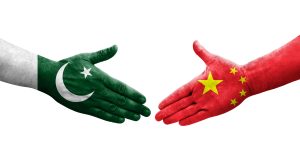In recent weeks, China and Pakistan have been showing an increased interest in developing deeper cooperation, specifically reenergizing the next phase of the China-Pakistan Economic Corridor (CPEC) project. In addition to security cooperation for Chinese personnel and projects in Pakistan, ongoing discussions between the two sides are seeking to resolve pending financial issues.
There are several projects across various sectors on Pakistan’s “wish list” for the next phase of CPEC. It is anticipated that the wish list will be presented to the Chinese premier, Li Qiang, when he visits Pakistan next month to attend the Shanghai Cooperation Organization summit in Islamabad.
Integral to this new phase of CPEC are five key corridors: growth, innovation, green initiatives, livelihood enhancement, and regional connectivity. Notably, they will facilitate progress on pending projects such as railway upgrades and the development of industrial zones – critical components that will bolster economic activity.
A noteworthy shift in strategy is evident as Pakistan seeks to transform CPEC into a business-to-business cooperation model. This approach invites private sector participation at its core.
Prime Minister Shehbaz Sharif recently articulated a vision where joint ventures between Pakistani and Chinese firms, particularly in textiles and agriculture, will be central to this initiative. These partnerships, as per the Pakistani premier, are poised not only for domestic growth but also for exporting products to markets with high demand.
Finance Minister Muhammad Aurangzeb has echoed these sentiments by advocating for a leading role for the Pakistani private sector in constructing this next phase of CPEC. According to the finance minister, by focusing on monetizing infrastructure rather than just building it, there’s an opportunity for sustainable economic growth that benefits both countries.
Moreover, the developing security cooperation between Pakistan and China is critical in addressing the challenges posed by threats to Chinese projects and personnel in Pakistan. The attacks targeting these initiatives have undeniably created friction, undermining the pace of progress on CPEC in recent years. Critics are right to highlight that the precarious security situation, particularly in Balochistan, continues to place significant stress on efforts aimed at enhancing CPEC-related cooperation.
However, amid these challenges lies a obvious urgency from both nations to forge solutions through innovative channels of collaboration. Recent exchanges of proposals signify a commitment from both sides to deepen their cooperation against militancy. Notably, a proposed anti-terrorism cooperation agreement suggests a proactive approach, with plans for establishing a joint security company dedicated to safeguarding Chinese citizens already engaged or set to engage during CPEC Phase II.
Moreover, China’s reported proposal for incorporating advanced security measures — such as vehicle-mounted mobile security equipment and armored vehicles — into Phase II underscores an understanding of the risks involved and a willingness to invest in protective strategies.
Pakistan’s receptiveness toward collaborating with Chinese officials marks a pivotal shift.
The recent high-level meetings between Pakistani Interior Minister Mohsin Naqvi and China’s Minister for Political and Legal Affairs Chen Mingguo reflected a strong desire from both sides not only to confront military challenges but to expand the discussion on the subject into other related areas. The partnership in this regard seems to be expanding beyond mere counterterrorism discussions as it includes cross-border cooperation on anti-smuggling and anti-narcotics initiatives as well.
Additionally, joint police-paramilitary force exercises in areas that link China and Pakistan, such as Xinjiang and Gilgit-Baltistan, are being discussed. This indicates the growing need for an integrated strategy to maintain stability along routes that are essential to the success of CPEC.
Furthermore, Pakistan’s ability to secure Chinese financial backing has been instrumental in negotiating a new agreement with the International Monetary Fund (IMF). China’s assistance has been vital because the country has not put excessive pressure on Islamabad to pay up outstanding CPEC payments or withdraw its $4 billion currency deposits, which is a necessary condition to seal the new IMF agreement. This indicates that China’s interests in Pakistan are strategic in nature and can withstand challenging circumstances.
Although both sides see the need to work together to find cooperative solutions to CPEC and security issues in the face of growing threats, doubts persist about whether these initiatives will actually address the underlying causes of instability or if they will only act as temporary fixes.

































